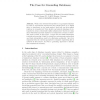Free Online Productivity Tools
i2Speak
i2Symbol
i2OCR
iTex2Img
iWeb2Print
iWeb2Shot
i2Type
iPdf2Split
iPdf2Merge
i2Bopomofo
i2Arabic
i2Style
i2Image
i2PDF
iLatex2Rtf
Sci2ools
GEOS
2009
Springer
2009
Springer
The Case for Grounding Databases
What is the intended interpretation of a geospatial database in terms of reproducible experiences? How should places on a digital globe be interpreted on the earth surface? And how can their spatial relations be reconstructed? How should road network databases be interpreted in terms of observable traffic infrastructure? And how is data about waterways and their depths to be interpreted in terms of observable water bodies? In this paper, I argue that successful information retrieval and querying of data in context-free environments requires that such data interpretations need to be effectively coordinated. I give four arguments why the current approaches to semantic engineering fail as methods in that respect, and why a ‘grounding’ approach to describe their semantics is necessary.
GEOS 2009 | Information Management | Observable Traffic Infrastructure | Observable Water Bodies | Semantic Engineering Fail |
| Added | 24 Jul 2010 |
| Updated | 24 Jul 2010 |
| Type | Conference |
| Year | 2009 |
| Where | GEOS |
| Authors | Simon Scheider |
Comments (0)

